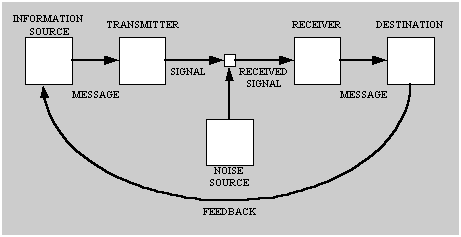This definition isn’t really revolutionary, but I appreciate the concreteness of it. It gives me another picture of the classic sender - receiver model, which is pictured below, but one wherein the Transmitter, Signal, Noise and Receiver are all quantified as being the work of the media.
 |
| Source: Wiki of Science |
One thing that’s struck me as I’ve been working through this book is that I typically think of expressing content through visual means as a form of new media communication. However, one thing that Flusser’s book points out to us is that this kind of communication isn’t new to the digital age. He says, “As the alphabet originally advanced against pictograms, digital codes today advance against letters to overtake them” (Kindle Location 1628). This reminder helps me to think about how a lot of technological revolutions are really a matter of remixing older artifacts.
What’s important about this observation is the humanity that Flusser sees in thoughtful remixing. He says, “We fear that in the future, all messages, especially models of perception and experience, will be taken in uncritically, that the informatic revolution could turn people into receivers who remix messages uncritically, that is, into robots. (Kindle Location 935). Like with the text of How We Became PostHuman, Flusser keeps returning to the cybernetic fear that we face if we change the way we code and recode information. However, he indicates that one characteristic that ensures us our humanity is this notion of critical remixing. In many ways, I think our clever use of remixing is what, even more than the empathy from Do Androids Dream of Electirc Sheep, makes us unique from the beast and robots of our society. In fact, I think many of the great thinkers of the contemporary age stand out to me as genius because of the way the can use remixing.
For me, there’s no greater example of this than my personal favorite: Quentin Tarantino.
This video, part of Kirby Ferguson’s Everything is a Remix Series, shows the beauty and detail through which Tranatino remixes to create Kill Bill.
As I think about remixing, I’m not hopeful that the robots of today or the near future will be able to remix in this way. But it does make me wonder: what would machines need to accomplish this task? What is it that makes humans skilled remixers?
Reference:
Flusser, Vilem. Does Writing Have a Future? Minneapolis: University of Minnesota Press, 2011. Kindle Edition.
No comments:
Post a Comment